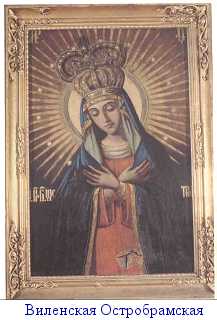Vilna ( Vilnius ) Ostrobramskaya icon of Mother of God
Approximately in 1363, Grand Duke Olgerd Gediminovich (Algirdas, son of Gediminas) of Lithuania captured the town of Chersonesus (Korsun). Among the spoils taken by the conqueror was an icon of the Mother of God, which the Grand Duke presented to his wife, luliania. The Grand Duchess installed the holy image in a newly built Monastery of the Holy Trinity. In the late 15th century, a stone wall was built round the city of Vilna (Vilnius) with the main gate at the "Russian" end of thecity, also known as the "Ostry" (Sharp) end. A chapel was built over the gate and the icon was placed into that chapel. In the course of time, Its former name, the Korsun Icon of the Mother of God, began to be forgotten and the holy image gradually came to be known as the "Ostrobramskaya" (from the name "Ostry" and "brama," meaning "gate" in Polish). In the early 17th century, the icon passed into the hands of the Uniates and, later on, the Roman Catholic Carmelite monks.The iconography of this icon reminds one of Roman-Catholic icons of the Mother of God. It is not unlikely that at one time it was part of an iconostasis or Holy Doors (a component of a composition depicting the Annunciation of the Most Holy Virgin). Feast days: December 26/January 8 and April 14/27.

